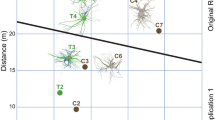Abstract
The relationship between responses of plants to trampling and their morphological characteristics was studied in a glasshouse experiment. Thirteen species with four different growth forms were used in this experiment. They were five tussock species.Chloris gayana, Eragrostis tenuifolia, Lolium perenne, Panicum maximum, andSporobolus elongatus; three prostate grasses,Axonopus compressus, Cynodon dactylon, andTrifolium repens, two herbaceous species,Daucus glochidiatus andHypochoeris radicata; and three woody species,Acacia macradenia, Acrotriche aggregata, andSida rhombifolia. These species were subjected to three levels of simulated trampling. For each species, measurements were taken of aboveground biomass, root biomass, leaf length, leaf width, leaf thickness, leaf number, broken leaf number and plant height. Overall, these measurements were greatest in the control plants, moderate in the level of light trampling, and the lowest in the level of heavy trampling. Biomass was used as a basis of the assessment of plant resistance to trampling. Three tussock species,Eragrostis tenuifolia, Lolium perenne, andSporobolus elongatus had a high resistance. Woody and erect herbaceous plants were more intolerant to trampling. There appear to be two processes involved in the reduction of the plant parameters: direct physical damage with portions of the plants detached, and physiological changes, which slow down vegetative growth rates. Plant height was found to be the most sensitive indicator of trampling damage.
Similar content being viewed by others
Literature Cited
Bates, G. H. 1935. The vegetation of wayside and hedgerow.Journal of Ecology 23:470–487.
Bowles, J. M., and M. A. Maun. 1982. A study of the effects of trampling on the vegetation of Lake Huron sand dunes at Pinery Provincial Park.Biological Conservation 24:273–283.
Bratton, S. P. 1985. Effects of disturbance by visitors on two woodland orchid species in Great Smoky Mountains National Park, USA.Biological Conservation 31:211–227.
Byrkit, D. R. 1987. Statistics Today, A comprehensive introduction. Benjamin/Cummings Publishing Co., Inc., Menlo Park, California.
Canaway, P. M. 1975. Turf wear: A literature review.The Journal of Sports and The Turf Research Institute 51:92–103.
Cole, D. N. 1988. Disturbance and recovery of trampled montane grassland and forests in Montana. Research paper. INT-389. US Department of agriculture, Forest Service, Intermountain Research Station.
Deans, J. D. 1968. Some aspects of the influence of treading on grasses. PhD thesis. Napier College of Science and Technology, Edinburgh.
Edmond, D. B. 1964. Some effect of sheep treading on the growth of 10 pasture species.New Zealand Journal of Agricultural Research 7:1–16.
Frenkel, R. E. 1972. Trampled vegetation and floristic convergence in the tropics.Association of Pacific Coast Geographers Yearbook 34:87–98.
Fushtey, S. G., D. K. Taylor, and D. Fairey. 1983. The effect of wear stress on survival of pure stands and on mixtures.Canadian Journal of Plant Science 63:317–322.
Goryshina, T. K. 1983. The effect of trampling caused by recreation on the internal structure of the leaf and thallus of some plants.Ekologiya 2:11–18.
Grabherr, G. 1982. The impact of trampling by tourists on a high altitudinal grassland in the Tyrolean Alps, Austria.Vegetation 48:209–219.
Hewitt, E. J. 1966. Sand and water culture method used in the study of plant nutrition, 2nd ed. Commonealth Bureau Horticultural and Plantation Crops. Technical Communication 22. Commonwealth Agricultural Bureau, Farnham Royal, Australia.
Jurko, A. 1983. Trampling effects on species diversity and leaf characteristics of vegetation in the high Tatras mountains.Ekologia (CSSR) 2:281–293.
Kellomaki, S., and V.-L. Saastamoinen. 1975. Trampling tolerance of forest vegetation.Acta Forestalia Fennica 147:5–19.
Kuss, F. R. 1986. A review of major factors influencing plant responses to recreation impacts.Environmental Management 10:637–650.
Liddle, M. J. 1973. The effects of trampling and vehicles on natural vegetation. PhD thesis. University College of North Wales, Bangor, Wales.
Liddle, M. J. 1975a. A selective review of the ecological effects of human trampling on natural ecosystem.Biological Conservation 7:17–36.
Liddle, M. J. 1975b. A theoretical relationship between productivity of vegetation and its ability to tolerate trampling.Biological Conservation 8:251–255.
Naito, T. 1969. Changes of alpine vegetation in Mt. Hakkoda due to human treading.Ecological Review 17:171–176.
O’Connor, K. F. 1956. Influences of treading on grasslands. PhD thesis. Cornell University, Ithaca, New York.
Pardhan, P., and R. S. Tripathi. 1983. Competition betweenTrifolium repens andPaspalum dilatatum as related to trampling.Acta Oecologica 4:345–353.
Sankey, J., and H. Mackworth-Praed. 1969. Headley Warren Reserve in 1968. The survey naturalist: Annual report for 1968.
Shearman, R. C., and J. B. Beard. 1975. Turf wear tolerance mechanisms: III. Physiological, morphological, and anatomical characteristics associated with turfgrass wear tolerance.Agronomy Journal 67:215–218.
Shildrick, J. P. 1974. A comparison of three seedling turf products.The Journal of Sports and The Turf Research Institute 50:95–107.
Sun, D., and M. J. Liddle. 1991. Field occurrence, recovery and simulated trampling resistance and recovery of two grasses.Biological Conservation 57:187–203.
Tothill, J. C., and J. B. Hacker. 1973. The grasses of southeast Queensland. University of Queensland Press, St. Lucia, Queensland.
Van der Horst, J. P., and H. A. Kamp. 1974. Sports turf research in the Netherlands.The Journal of Sports and The Turf Research Institute 50:81–94.
Willard, B. E., and J. W. Marr. 1970. Effects of human activities on alpine tundra ecosystems in Rocky Mountain National Park, Colorado.Biological Conservation 2:267–265.
Youngner, V. B. 1961. Accelerated wear tests on turfgrasses.Agronomy Journal 53:217.
Author information
Authors and Affiliations
Rights and permissions
About this article
Cite this article
Sun, D., Liddle, M.J. Plant morphological characteristics and resistance to simulated trampling. Environmental Management 17, 511–521 (1993). https://doi.org/10.1007/BF02394666
Issue Date:
DOI: https://doi.org/10.1007/BF02394666




